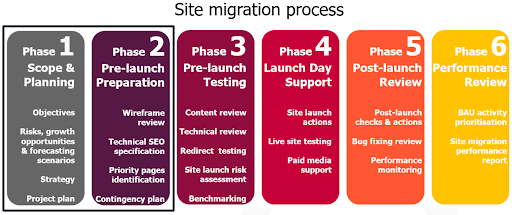The importance of SEO at the start of a website migration
Rebranding your website, switching to a new CMS or revamping website structure are all valid reasons why you may be embarking on a website migration project. But have you factored in a technical SEO audit at the start of the process?
Unfortunately, all too often, an audit is undertaken, not at the start of a migration project but post-migration, when irreparable damage has already occurred. This is a fundamental mistake that many in-house marketers and business owners continue to make, that often proves costly.
But why does this keep on happening?
Migrations are an expensive endeavour, going through multiple teams and phases. Yet many organisations, eager to see the end result, rush into the launch process without fully considering the consequences.
Once a website is live, even small changes in structure or URL format can have serious implications, which will almost certainly require extra development costs and time to rectify. Such scenarios underline why it’s important to take the time to get the foundations right first, for any migration. That way, you can ensure you make a good impression with Google upon launch and save yourself some budget.
Here are just some of the most common complaints I hear from clients who come to us after rushing a migration:
“The website has had a huge decrease in traffic and conversions since we migrated.”
“The website is so slow and we’re not getting any enquiries!”
“The website keeps breaking and pages go to 404 errors.”
“Why are my pages not showing in Google?!”
“My Google results are taking me to the wrong page on my new website.”
These are all issues that could have been resolved by an SEO team during the migration process.
However, every migration is different and whilst there are many guides out there on how to successfully oversee a migration, there is no one-size-fits-all solution. Migration projects are most successful when they involve an SEO specialist agency alongside your UX and development teams.
For that reason, I want to look at the importance of the first two stages of a migration process, as shown in the graphic below. A migration done correctly shouldn’t only try and protect organic visibility, but it also should serve as the foundation for organic growth, thus ‘future-proofing the website’.

Planning and preparation for a website migration
At this stage, you should begin laying out key goals and possible roadblocks, alongside opportunities and timescales. No migration process is complete without conducting a thorough keyword research in this phase, analysing both your own key organic pages and your rivals’. Without this research, you cannot understand the opportunities or begin forecasting..
From this intelligence, you can build a website architecture that not only makes sense from a user standpoint, but also from Google’s perspective. The target keywords from the audience analysis will form the basis of your URLs, metadata and content. If a website is launched with unoptimised URLs and metadata, and a lack of content, it can be very difficult to build trust with Google and rank for target queries.
Common technical SEO migration mistakes
A common theme and issue with migrations is ensuring search engines can access your content. So it’s important to consider the crawlability and indexability of a new website, as this is where small issues may have large consequences. These include:
- Robots access
By preventing access to the new website or allowing access to the staging website, you will disrupt the migration process and hinder a smooth transition.
- Lack of XML sitemap
An XML sitemap acts as a blueprint for the new website, playing a pivotal role in search engines’ ability to crawl and index your website. Without one, you may find the transition can take longer and affect organic visibility.
- Missing breadcrumbs (and schema)
A less obvious issue is missing breadcrumbs. Breadcrumbs are important in displaying a new website’s structure to users and Google. They act as clear pathways and leverage internal link equity.
Other key issues revolve around user experience:
- Redirects
Be sure to factor in current and legacy redirects into the redirect mapping process – to make certain users don’t land on 404 error pages or that any authority is lost.
- Page speed
Page speed and experience are not only important for user experience, but they’re also a ranking factor on both mobile and desktop.
- Neglecting mobile experience
Google has moved to the mobile-first index, so even if most of your traffic or revenue comes from a desktop device, you will be judged upon your mobile experience.
Major website changes can feel like a gamble but done properly they can be a real opportunity to increase your organic footprint. Any dramatic change in structure can affect rankings, traffic and conversions in the short term. As such, it’s vital that you enlist the help of an SEO team early in the migration process – to ensure your website is fully compliant with Google best practice and to guarantee that you don’t lose search engine visibility. Not only will this bring greater efficiencies and save you valuable time, it will also avoid expensive remedial costs in the long-term.



